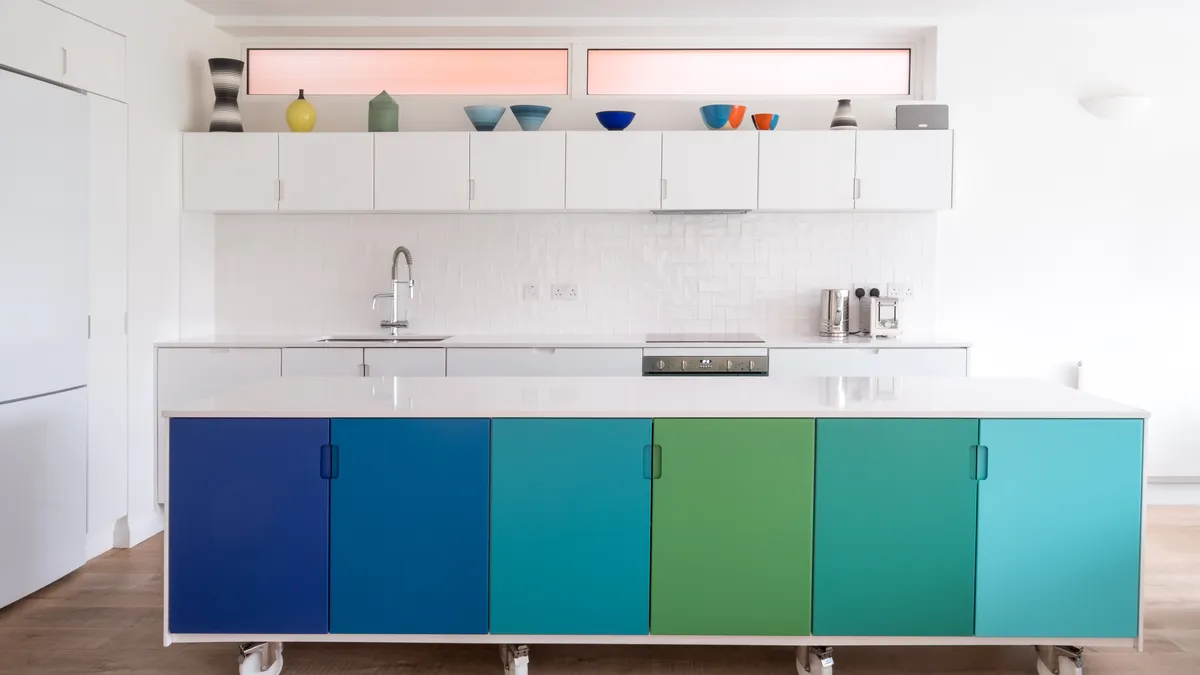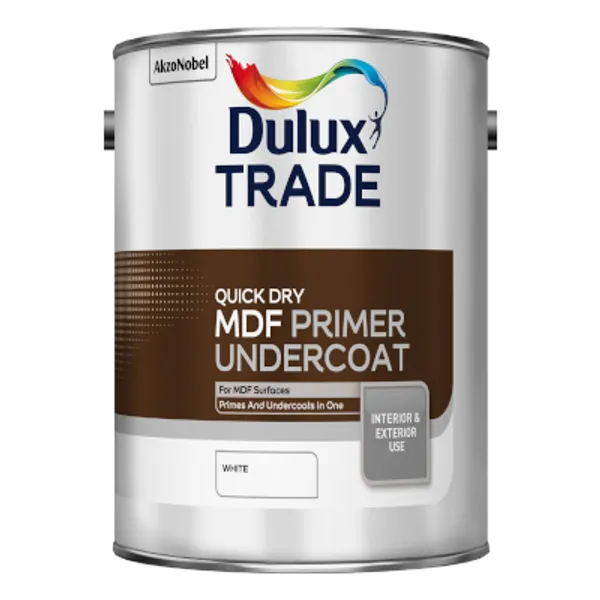Painting MDF - The Ultimate Guide
When it comes to MDF there is a lot of confusion surrounding whether you can paint it or not. In this guide we are going to answer the most common questions regarding painting MDF so you can decide on the best course of action.

Can You Paint MDF?
Firstly, let's answer the question of what exactly is MDF and whether you can paint it, as it is a question we receive a lot here at Painters World. MDF stands for 'Medium-Density Fibreboard', a commonly used material for the production of furniture and other building materials around the world. It consists of a combination of sawdust and resins that make it inexpensive and easy to cut. Common uses for MDF include kitchen cabinets and furniture such as dressing tables and wardrobes.
To answer the question of whether you can paint MDF, the answer is simple, yes you can paint MDF. As with any painting project, it must be properly prepared and painted with the most suitable paint for its particular composition. MDF has a 150 grit on the front and back sides while the edges are much more rough than this, making them highly porous This means that they must be prepared in order to create a uniform substrate ready to paint.
Benefits & Drawbacks of MDF
It is crucial to understand MDF before beginning the process of painting it. Here are the key benefits and drawbacks of MDF as a material:
Benefits
- The small fibres that make up MDF make it a very smooth surface on the face of the material, giving you a good surface to paint
- With no visible grain to the wood due to its composition, it has a uniform appearance
- It is less volatile to movement compared to a natural wood surface, which helps to prevent paint cracking
Drawbacks
- You must wear the appropriate safety gear as MDF causes a large amount of dust when sanding and sawing
- With no grain, it does not have the texture that many people want when staining wood
- MDF is porous and can absorb water, which is why many people recommend using oil-based paint over water-based paint, although you can use both on MDF if it is properly primed and sealed
What Is The Best Paint For MDF?
Primer
When painting bare MDF it is crucial to seal it using an MDF primer. We would highly recommend using Dulux Trade Quick Dry MDF Primer as it acts as a primer and undercoat in one that has been specially designed for use on MDF. It can be used on interior and exterior MDF and as a water-based primer is quick-drying and low odour.
Paint
With the water-based primer of Dulux Trade Quick Dry MDF Primer, we would recommend opting for Crown Trade Fast Flow QD Satin as the best paint to use on MDF. This is for a number of reasons, the first of which being that satin is the most popular paint finish for furniture. Further to this, using a water-based primer means that a water-based topcoat must be used, in which Fast Flow by Crown Trade Paint is one of the best on the market. As a water-based satin, it benefits from a quick drying time, being low odour and will not yellow, which is a problem with oil-based paints. It offers all this while ensuring an attractive oil-like finish.
Finally, it can be mixed in any colour, which means that no matter what look you want to achieve with your MDF furniture, it is possible. This includes British Standard, Crown and RAL shades, plus equivalents of all other major manufacturers colours, including designer shades. All you have to do is tell us the name of the shade and we do the rest.
How To Paint MDF
So you now know what the best paint and primer to use on MDF are. Now let's talk about how exactly to go about painting them!
Step 1: Cleaning & Sealing
One of the most important steps of any decorating project, as any professional decorator will tell you, is preparation.
Firstly, if the MDF has dirt or grime on it, this must cleaned before we begin priming and painting. A universal cleaner such as Zinsser Universal Degreaser & Cleaner can be used, which is then wiped down with a cloth ensuring that no residue is left.
As we have mentioned, the edge of MDF often has a much rougher edge that absorbs moisture more than the back and front of the substrate. These edges if they haven't previously been sealed must be treated so it will accept the paint in the same way as the rest of the surface. This can be done by first sanding the edges using a 120-grit sandpaper to smooth the surface of the MDF. You must ensure that you are wearing protective goggles and a mask when sanding MDF as it contains dust and glues that hold the substrate together that can be harmful to health.
Once you have sanded down the edge, you can apply a number of layers of Dulux Trade Quick Dry MDF Primer to seal these edges, before the rest of the MDF is primed. This gives the corners an extra level of primer in order to prep them for painting. This is most easily done with a small paint brush.
Once this primer has dried sand down the edges of the MDF once again with a 120-grit sandpaper. The next stage is to apply primer to the rest of the MDF using Dulux Trade Quick Dry MDF Primer once again. You can use a mini-roller or a brush to apply the primer. Ensure you apply a generous but even layer of primer.
If you have previously painted and sealed MDF it is not necessary to prime this before painting. You can move straight to apply a first-coat of paint.
Step 2: Sanding
After you have primed and sealed the MDF, it is time to prepare the full surface for painting. Ensuring that you are wearing protective goggles and a mask, sand down the full MDF surface with a light key sandpaper (such as 120-grit).
Step 3: Priming
Once the MDF has had a light sand, you can apply a second coat of primer as evenly as possible, creating a final base that is ready to be painted. While this seems like a long-winded process, the preparation that goes into painting is what sets apart good results and perfect results.
Step 4: Painting
Now the important part, the painting. Using a brush or mini-roller again, apply a first-coat of paint to the MDF nice and evenly to create an excellent undercoat for finishing. Leave this to dry completely as per the manufacturers instructions. The chances are you will require a second-coat of paint, which you should apply so that the MDF has a good paint film applied.
It's important to note that MDF is porous, which may mean that you will require more paint than you would expect.
Step 5: Finishing
If the MDF will be taking heavy-traffic and may be prone to scuffs, it is a good idea to preserve the finish using a final sealing finish such as Sadolin Extra Durable Clearcoat. This is optional, especially if you do not want to add an extra level of sheen to the MDF, which a gloss polyurethane can leave.

Frequently Asked Questions
Q. Does painting MDF make it waterproof?
By painting MDF like any surface, you help to create a film on the surface that can resist some level of moisture. While painting MDF doesn't waterproof it, it does help to prevent water damage. To fully waterproof MDF especially if you are using it outdoors, paint it with a dedicated water-repellent.
Q. Does painting MDF prevent mould?
By providing some water resistance to MDF, painting it does help to prevent mould and damp. This is particularly helpful if you are keeping MDF furnishings in high moisture rooms such as garages or bathrooms where bare MDF will absorb moisture quickly.
Q. Can I paint MDF without primer?
As with any surface, you can apply paint without priming before hand, but the results will not be optimal. The MDF will absorb the paint quickly meaning you will use more paint than needed and the whole process will be more time-consuming. This will especially be the case with a water-based paint.
Q. Is it safe cut MDF?
As we have mentioned, MDF contains a mix of dust, fibres and glues that can all be harmful to health. This is why it is crucial if you are sanding or cutting MDF, you use a mask and eye protection to prevent any harm.
Q. Is oil-based paint or water-based paint better for MDF?
You can use both oil-based paint and water-based paint on MDF. In general, while oil-based paint has traditionally been higher quality than water-based paint, todays technology means that water-based paint is just as good.
Water based paints dry quicker than oil based, are low odour, do not yellow and contain less VOC's. Oil-based paints can achieve a higher level of sheen, can achieve less brush strokes and offer higher durability. Overall, water-based paints are recommended for DIY'ers as they are much easier than oil-based paints to use and clean up, which is why we would recommend them.
We hope this has answered any questions you may have had regarding painting MDF. At Painters World we have a wide range of paints available, so no matter the job, we've got the right tools for you! Shop our huge range of products today & get FREE next working day delivery on all orders over £50.



Sign up now and be the first to know about exclusive offers, product updates, and announcements.


